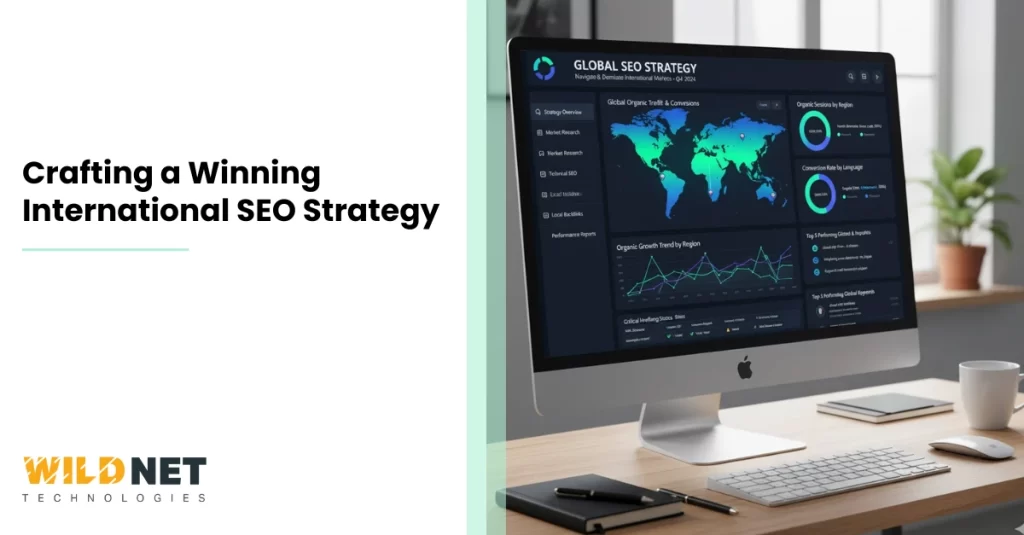Expanding your online presence globally is a game-changer. It opens doors to new markets and diverse audiences. But how do you ensure your website stands out internationally?
An effective international SEO strategy is key. It helps your site rank well in search engines across different countries. This means more visibility and potential customers.
International SEO involves more than translating content. It involves understanding cultural nuances and search behaviors, and you need to tailor your approach to each target market.
Keyword research is crucial. It identifies what potential customers are searching for in different regions. This guides your content and optimization efforts.
Another important step is choosing the right domain structure. This affects how search engines perceive your site’s relevance to specific countries.
Technical SEO ensures your site performs well globally. It addresses issues like site speed and mobile compatibility.
Finally, measuring your strategy’s success is vital. Use analytics to track performance and make necessary adjustments.
Understanding International SEO: Why It Matters
International SEO is critical for businesses aiming to enter the global market. It aligns your website with the preferences and expectations of diverse audiences worldwide, increasing your brand’s credibility and reach.
Understanding the importance of international SEO involves recognizing how search engines rank content in different countries. Search engines consider various factors, including language, location, and search intent, which can vary significantly from one region to another.
Here are a few reasons why international SEO is essential:
- Reaches new audiences: Enter untapped markets with tailored strategies.
- Improves visibility: Higher rankings lead to more traffic.
- Boosts brand reputation: Appearing in local searches enhances credibility.
Investing in international SEO ensures you’re not missing out on potential markets. It helps you understand and cater to diverse customer needs. Furthermore, it fosters long-term brand growth and competitive advantage. Recognizing these benefits motivates businesses to craft tailored strategies.
Assessing Your Global Readiness
Before diving into international SEO, assess your current digital presence and consider whether your website can support an international audience. This includes evaluating your infrastructure, such as server capacity and website speed.
Next, identify if you have a unique value proposition in foreign markets. Understand the demand for your products or services in other countries. Not all markets will have equal interest or potential for growth.
Evaluate potential barriers to entry in your target regions. Cultural differences, language barriers, and local competition could pose challenges, which may influence your marketing approach.
Here’s a checklist to consider:
- Audience demand: Is there a significant interest in your offerings?
- Website performance: Can your website handle increased traffic?
- Cultural understanding: Are you aware of local cultural nuances?
Assessing these elements will help to shape a targeted international SEO approach. It ensures that when you expand, you’re ready to succeed.
International Keyword Research: Finding the Right Opportunities
International keyword research is crucial for global SEO success. It helps pinpoint what terms your target audiences use, ensuring that your content aligns with their search behavior.
Start by choosing the right tools for international research. Google Keyword Planner and SEMrush are excellent options. These tools help identify popular search terms in various regions.
Remember, keywords vary across languages and regions. A phrase in English might differ in another language. Ensure that your translations respect cultural nuances.
Here’s how to conduct effective international keyword research:
- Leverage local insights: Collaborate with native speakers.
- Use regional keyword tools: Access data from relevant search engines.
- Focus on search intent: Understand what users want to find.
Also, consider the competitiveness of your chosen keywords. High competition may require more effort. Finding a balance between search volume and competition is key.
Another vital aspect is seasonal trends in different countries. Some keywords may be popular only during certain times. Recognizing these patterns can give you an edge.
To summarize, international keyword research is a multifaceted process. It’s about understanding linguistic and cultural context. Tailoring your strategy accordingly can unlock global opportunities.
Choosing the Best Domain Structure for International SEO
Selecting the proper domain structure is pivotal for international SEO. It affects how search engines and users perceive your content.
Common domain structures for international sites include:
- ccTLD (country code Top Level Domain): Example: website.fr for France.
- Subdomains: Example: fr.website.com.
- Subdirectories: Example: website.com/fr.
Each option has its merits and drawbacks. ccTLDs strongly signal to search engines that a site is country-specific. However, they can be costly to maintain and require separate SEO efforts.
Subdomains allow for flexible management of international content. However, if not handled properly, they can dilute domain authority. Subdirectories are easy to implement but may not convey the same level of localization as ccTLDs.
Consider these factors when choosing a domain structure:
- Budget: Cost of maintaining multiple domains or subdomains.
- Brand consistency: Keeping the brand unified across regions.
- SEO resources: Capacity to optimize each version separately.
Your choice should align with your target market and business goals. Balancing technical SEO needs with user experience is essential. Correctly setting up your domain structure lays a solid foundation for international success.
Language and Region Targeting: Hreflang, Localization, and More
Effectively targeting different languages and regions is key to international SEO success. This ensures your content reaches the right audience.
Hreflang tags are essential for signaling to search engines which language and country a page targets. These tags help avoid duplicate content issues and improve user experience. Implementing them correctly can boost search visibility in your target markets.
Localization goes beyond simple translation. It involves adapting content to local cultures, norms, and preferences. This can include tailoring currency formats, measurements, or even colors and imagery to suit local tastes.
Consider these aspects when localizing content:
- Cultural references: Use relevant, relatable examples.
- Spoken language: Account for local dialects and slang.
- User expectations: Align with the regional consumer journey.
Regularly audit your site to ensure updates in regional preferences and language shifts. Also, consider using local hosting providers for faster site delivery in target regions.
An international SEO strategy should focus on delivering a local experience globally. Doing so will resonate with diverse audiences and enhance your brand’s global reach. Proper targeting forms the backbone of an effective international strategy.
Content Localization: Beyond Translation
Content localization transforms your message to resonate with local audiences. It’s more than just language translation; it’s about cultural adaptation.
To localize effectively, you must understand the nuances of your target markets. This involves recognizing local customs, cultural differences, and preferences. Tailoring your content can significantly enhance user engagement.
Here are key elements to consider in localization:
- Cultural relevance: Use local idioms and references.
- Visual content: Adapt images to suit cultural sensibilities.
- Context: Ensure examples are region-specific.
Successful localization results in content that feels native to each market. This increases trust and relatability, encouraging higher interaction rates.
Remember, localization requires continuous monitoring. Markets evolve, and your content should too. Stay updated with local trends and changes. Ensuring your content stays relevant is essential for maintaining global success.
This holistic approach can differentiate your brand in crowded international markets. Localized content that connects with audiences will consistently outperform mere translations.
SEO Internal Linking Strategy for Global Sites
An effective SEO internal linking strategy helps search engines understand your site structure, improves navigation, and enhances user experience.
Internal linking becomes more intricate for global sites. Your site should connect seamlessly with each language or regional version.
Key steps for successful internal linking include:
- Organize content: Categorize by region or language.
- Cross-linking: Connect related content across different language sites.
- Hierarchy: Ensure logical flow from general to specific topics.
Cross-linking between localized content ensures users find relevant information easily. This also helps search engines crawl and index the content.
Always monitor broken links. Regular audits maintain link integrity, which is essential for SEO health. Adjust internal links when restructuring content to avoid orphan pages. A strong internal linking strategy supports global SEO success by efficiently guiding users and search engines through your site.
Technical SEO for Multiple Countries and Languages
Technical SEO is crucial for sites targeting multiple countries. It ensures accessibility and performance remain top-notch across diverse regions.
To optimize your site technically, consider the following:
- Hreflang tags: Define content language and geographical targeting.
- Mobile optimization: Cater to varying device preferences internationally.
- URL structure: Use clear and understandable URLs for easy navigation.
Hreflang tags inform search engines about the intended audience. This minimizes duplicate content issues by showing the right content to the right users.
Mobile optimization must not be overlooked. Different countries have different mobile usage trends, which impact user experience.
Ensure URLs are straightforward. Complex URLs can deter both search engines and users. Effective technical SEO lays the foundation for successful international ventures. Regular technical audits help identify issues promptly and keep the site performing optimally. By focusing on these aspects, you can ensure your site’s global visibility and user satisfaction.
Building Local Authority: Backlinks and Social Signals
Building a local authority boosts your site’s credibility in international markets. Backlinks from local sites show your relevance in specific regions.
Prioritize obtaining high-quality backlinks from reputable local websites. These links signal to search engines that your site is trusted, boosting your regional ranking.
Social signals also play a part in local SEO. Active engagement on region-specific social platforms enhances visibility, and tailored content aligned with local interests encourages shares and comments.
Consider these strategies for building local authority:
- Engage with local influencers: Partner with influencers who resonate with your target audience.
- Create locally relevant content: Develop content that meets the regional audience’s needs.
- Participate in local online forums: Actively engage in discussions relevant to your industry.
Consistency in local interactions cultivates trust. Focusing on backlinks and social signals can solidify your presence in international markets.
Promoting an English Language Website Internationally
Promoting an English-language site globally requires strategic finesse. Tailoring your content to diverse audiences boosts engagement, and cultural nuances are crucial for global reach.
Content adaptation is more than translation. It involves localizing messaging to align with regional preferences, which resonates better with local audiences and drives traffic.
Optimizing your site for international search engines is also essential. Many regions have preferred search engines like Baidu or Yandex. Ensuring your site complies with their standards enhances visibility.
Consider these tactics for promoting your site internationally:
- Geo-targeting ads: Deliver content specifically adapted to regional interests.
- Localize your SEO: Incorporate local keywords into your SEO plan.
- Engage with local social networks: Use platforms popular in your target regions for direct engagement.
These strategies help you effectively promote your English language site internationally. By being sensitive to local contexts, you gain a competitive advantage.
Measuring and Optimizing Your International SEO Strategy
Evaluating the success of your international SEO strategy is crucial. It helps identify improvement areas, and continuous monitoring allows for timely adjustments.
Use analytics tools to track key performance indicators. Google Analytics and Search Console provide insights into traffic sources. This data reveals your audience’s regions and languages.
Review your keyword performance regularly. Identify which terms drive traffic in different countries. This will help refine your content strategy for improved targeting.
Consider these steps for effective measurement and optimization:
- Monitor search rankings: Check positions for international keywords consistently.
- Assess user engagement: Track metrics like bounce rates and session durations.
- Analyze conversion rates: Examine how well your site converts visitors from each region.
Optimizing based on solid metrics ensures your strategy stays relevant. Understanding these dynamics allows you to adapt quickly and maintain global competitiveness.
Common Pitfalls and How to Avoid Them
Crafting an international SEO strategy has its challenges. Common pitfalls can undermine your efforts, so it’s essential to recognize and address them.
Neglecting cultural differences can alienate potential customers. Ensure your content and keywords align with local sensibilities. This cultural alignment fosters greater connection with your audience.
Technical errors can also hinder SEO performance. Incorrect hreflang implementation is a frequent issue. Proper setup is vital for correct regional targeting.
Consider these pitfalls to steer clear of:
- Ignoring local competition: Evaluate competitors in each market.
- Overlooking mobile optimization: Ensure seamless access on all devices.
- Weak internal linking: Strengthen your site’s navigation for better indexing.
Avoiding these pitfalls will empower you to create a robust, efficient international SEO strategy. Remaining proactive in addressing these issues can lead to sustained global success.
Conclusion: Evolving Your International SEO for Long-Term Success
In the ever-changing world of international SEO, adaptability is key. The digital landscape evolves rapidly, necessitating constant vigilance and updates. Success requires more than an initial plan; it demands continual refinement.
Monitoring your strategy’s effectiveness is critical. Use analytics to discern areas for improvement. Adapt based on performance data and emerging trends to stay competitive globally.
A commitment to ongoing learning and adaptation distinguishes successful international SEO efforts. By remaining flexible and open to change, you ensure your approach stays adequate and relevant for long-term global growth.
By implementing strategies like these, businesses can unlock new growth opportunities and stay ahead of competitors in the ever-evolving digital landscape. If you’re ready to take your online presence to the next level, our expert team is here to help. As a trusted SEO services and digital marketing company, we specialize in driving measurable results, improving rankings, and maximizing ROI—partner with us today to transform your visibility and turn search traffic into lasting business success.
1. What is international SEO?
International SEO is optimizing your website so search engines can identify which countries and languages you are targeting, helping you reach global audiences effectively.
2. Why do businesses need an international SEO strategy?
Without proper optimization, your website may not rank in the right country or language, causing missed opportunities in global markets.
3. What are hreflang tags, and why are they important?
Hreflang tags tell search engines which version of a page to show to users based on language and region, preventing duplicate content issues.
4. How long does it take to see results with international SEO?
Results vary, but businesses usually start noticing improvements in international visibility and traffic within 4–6 months of implementing a proper strategy.
5. Should I hire an SEO agency for international SEO?
Yes. An experienced SEO agency can handle complex tasks like localization, technical setup, and content optimization, ensuring your brand succeeds in global markets.
Read More






